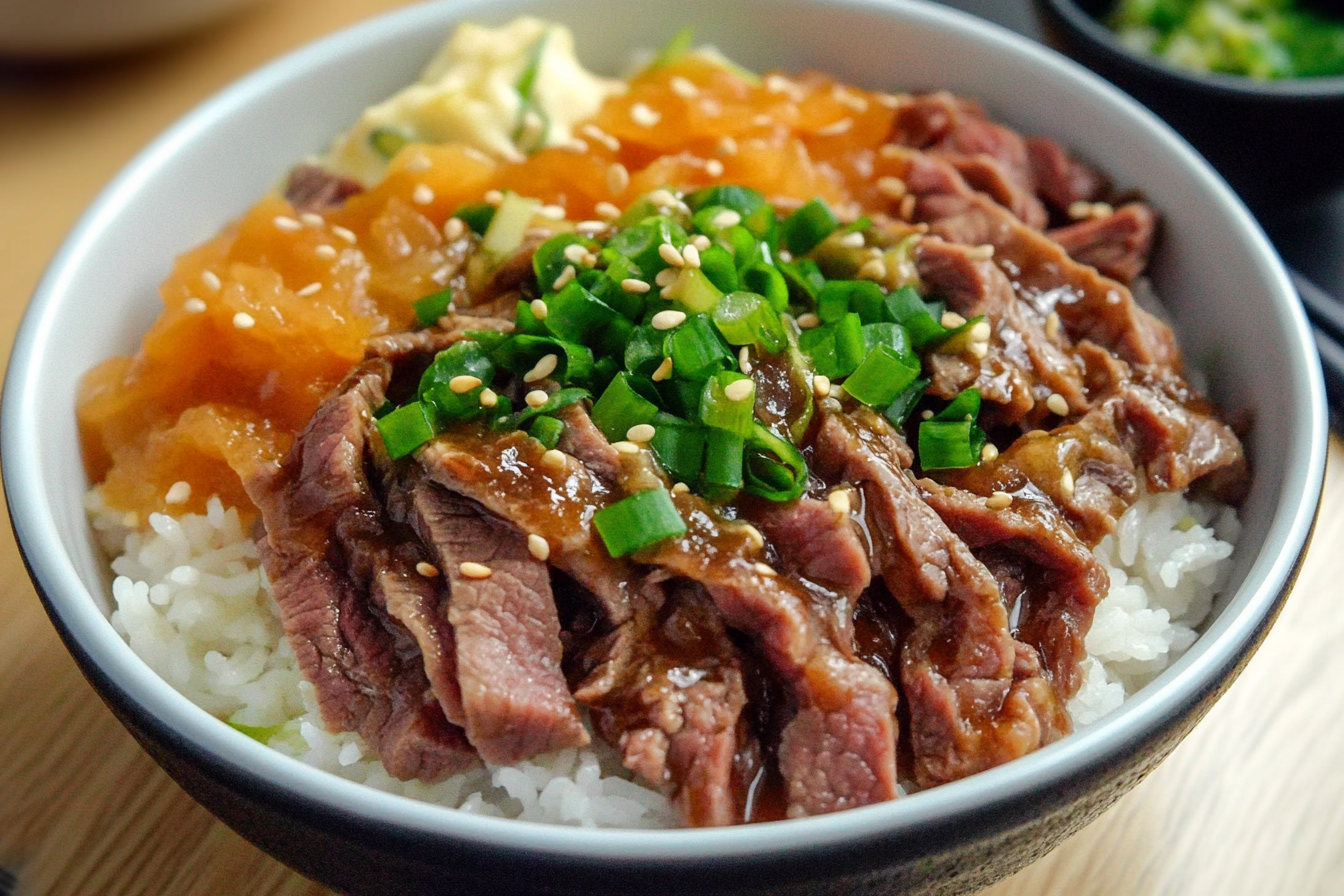If you’ve ever craved the mouthwatering flavors of fast-food Japanese beef bowls, you’re in for a treat. This recipe for Copycat Yoshinoya Beef Bowls brings those savory, tender beef strips and perfectly steamed rice straight to your kitchen. Whether you want a quick dinner or a comforting meal to share, these bowls come loaded with authentic flavors that make every bite truly special without any restaurant hassle.
Why You’ll Love This Recipe
- Authentic Taste: Experience the rich, savory flavor of Yoshinoya’s beef bowls made right at home with simple ingredients.
- Quick and Easy: This recipe takes just minutes from start to finish, perfect for busy weeknights or last-minute cravings.
- Comfort in a Bowl: Warm, hearty, and filling, it’s like a cozy hug in food form that satisfies every time.
- Customizable: You can easily adapt the ingredients to fit your dietary preferences or to add your own tasty twist.
- Budget-Friendly: Uses affordable pantry basics without compromising on flavor or quality.
Ingredients You’ll Need
Gathering the right ingredients is key, but don’t worry—this recipe keeps it straightforward. Each element plays an important role, from the tender beef to the umami-packed sauce that coats every bite perfectly.
- Thinly sliced beef: Choose ribeye or sirloin for tender, flavorful meat that cooks quickly.
- Onion: Adds natural sweetness and balances the savory and tangy sauce.
- Steamed white rice: The perfect fluffy bed that soaks up all the delicious juices.
- Soy sauce: Brings deep umami and saltiness to mimic the restaurant’s signature taste.
- Mirin: A sweet rice wine that adds gentle sweetness and a silky finish.
- Sugar: Balances the salty and savory elements for a rounded flavor profile.
- Dashi or beef broth: Delivers underlying depth and richness to the sauce.
- Ginger and garlic: Fresh aromatics that brighten the dish and add warmth.
- Sesame oil (optional): For a subtle nutty aroma in the final dish.
Variations for Copycat Yoshinoya Beef Bowls
Feel free to make this recipe your own! It’s incredibly flexible, allowing you to swap ingredients or add extras to suit your taste buds or dietary needs without losing that signature flavor.
- Beef alternatives: Substitute thinly sliced chicken, pork, or even mushroom slices for a vegetarian twist.
- Make it spicy: Add a dash of chili flakes or sriracha to the sauce for a kick of heat.
- Veggie boost: Toss in sliced bell peppers, spinach, or shredded cabbage for extra crunch and nutrition.
- Low-sodium version: Use low-sodium soy sauce and broth to reduce salt without sacrificing flavor.
- Rice swap: Try brown rice or cauliflower rice for a healthier, fiber-filled option.

How to Make Copycat Yoshinoya Beef Bowls
Step 1: Prepare the Sauce
Start by whisking together soy sauce, mirin, sugar, and dashi or beef broth in a small bowl—this magical mixture creates the signature savory-sweet base for your beef bowls.
Step 2: Sauté Aromatics and Onions
Heat a bit of oil in a skillet, then add finely chopped garlic and grated ginger. Once fragrant, toss in thinly sliced onions and cook until they soften and start to caramelize, adding natural sweetness to the dish.
Step 3: Cook the Beef
Add your thinly sliced beef to the pan, spreading it out evenly. Pour the prepared sauce over the meat, letting it bubble and simmer gently until the beef is tender and fully coated with that irresistible sauce.
Step 4: Steam the Rice
While the beef simmers, prepare your rice according to package instructions or preferred method, making sure it’s fluffy and hot for your bowls.
Step 5: Assemble the Bowls
Serving time! Spoon generous portions of steamed rice into bowls, then top with the saucy, tender beef mixture. A perfect balance of textures and flavors awaits.
Pro Tips for Making Copycat Yoshinoya Beef Bowls
- Choose the right cut: Thinly sliced ribeye or sirloin works best to replicate the restaurant’s tenderness.
- Don’t overcrowd the pan: Cook in batches to ensure even browning and tenderness.
- Let the sauce reduce: Simmer long enough so it thickens and clings beautifully to each slice of beef.
- Use freshly grated ginger: It adds a bright and fresh flavor that pre-ground powder can’t match.
- Rest your rice: Keep it covered and warm until serving to maintain fluffiness.
How to Serve Copycat Yoshinoya Beef Bowls
Garnishes
Top your beef bowls with thinly sliced green onions, pickled ginger, or a sprinkle of toasted sesame seeds for added freshness and texture.
Side Dishes
Complement the warm beef bowls with a side of miso soup, steamed edamame, or a crisp seaweed salad to round out the meal.
Creative Ways to Present
For a fun twist, serve the beef over sushi rice and spiralized vegetables, or arrange the beef and rice in a bento box with colorful sides to impress your guests visually and gastronomically.
Make Ahead and Storage
Storing Leftovers
Store any leftover beef and rice separately in airtight containers in the fridge for up to 3 days to maintain flavors and freshness.
Freezing
Freeze cooked beef and sauce in a freezer-safe container for up to one month. Rice tends to lose texture when frozen, so it’s best to prepare fresh rice upon reheating.
Reheating
Reheat beef gently in a skillet over low heat with a splash of broth or water to keep it moist. Warm rice separately in the microwave or on the stove with a lid on to steam it back to life.
FAQs
What kind of beef is best for Copycat Yoshinoya Beef Bowls?
Thinly sliced ribeye, sirloin, or any tender cut meant for quick cooking is ideal. Look for pre-sliced beef at Asian markets or slice your own while it’s partially frozen for best results.
Can I make this recipe vegetarian or vegan?
Absolutely! Swap the beef for mushrooms, tofu, or seitan, and use vegetable broth instead of dashi or beef broth to keep the savory depth intact.
Is mirin necessary in the recipe?
Mirin adds a subtle sweetness and depth that balances the soy sauce, but if you don’t have any, a mix of sake and sugar or dry sherry with sugar can work as a substitute.
How long will this dish keep in the refrigerator?
When stored properly in airtight containers, the components will stay fresh for up to 3 days—perfect for meal prepping or leftovers.
Can I use brown rice instead of white rice?
Yes! Brown rice offers a nuttier flavor and more fiber, making the dish even heartier. Just be mindful it takes longer to cook than white rice.
Final Thoughts
There’s something so wonderfully satisfying about digging into a bowl full of savory, tender beef paired with fluffy rice, all laced with that signature Yoshinoya sauce. Making Copycat Yoshinoya Beef Bowls at home lets you savor that delicious experience any night of the week. No need to wait in line or order takeout—grab your ingredients, follow the steps, and enjoy a warm, cozy meal that tastes just like your favorite restaurant’s special.
Related Posts
- Quick and Fun Tortilla Wrap Pizza for Busy Weeknights
- Ultimate Coney Island Chili Dogs You Can Make at Home
- Hearty John Wayne Casserole for Comfort Food Lovers

Copycat Yoshinoya Beef Bowls
- Prep Time: 10 minutes
- Cook Time: 15 minutes
- Total Time: 25 minutes
- Yield: 4 servings
- Category: Main Course
- Method: Sautéing
- Cuisine: Japanese
- Diet: Contains meat, can be adapted to vegetarian or vegan
Description
Copycat Yoshinoya Beef Bowls bring the authentic, savory, and tender flavors of the popular fast-food Japanese beef bowls right to your kitchen. This quick and easy recipe combines thinly sliced beef, flavorful aromatics, and a signature umami-packed sauce served over fluffy steamed rice, perfect for a comforting and customizable meal any day of the week.
Ingredients
Beef and Aromatics
- 300g thinly sliced beef (ribeye or sirloin preferred)
- 1 medium onion, thinly sliced
- 2 cloves garlic, finely chopped
- 1 tablespoon fresh ginger, grated
- 1 teaspoon sesame oil (optional)
Sauce
- 1/4 cup soy sauce
- 3 tablespoons mirin
- 2 tablespoons sugar
- 1/2 cup dashi or beef broth
Rice
- 2 cups steamed white rice (prepared according to package instructions)
Instructions
- Prepare the Sauce: In a small bowl, whisk together 1/4 cup soy sauce, 3 tablespoons mirin, 2 tablespoons sugar, and 1/2 cup dashi or beef broth until the sugar dissolves, creating the signature savory-sweet base for the beef bowls.
- Sauté Aromatics and Onions: Heat a bit of oil in a skillet over medium heat. Add finely chopped garlic and grated ginger and sauté until fragrant. Add thinly sliced onions and cook, stirring occasionally, until they soften and begin to caramelize, which enhances natural sweetness.
- Cook the Beef: Spread the thinly sliced beef evenly in the skillet with the aromatics and onions. Pour the prepared sauce over the meat. Let the mixture simmer gently, stirring occasionally, until the beef is tender and fully coated with the thickened sauce, about 5-7 minutes.
- Steam the Rice: While the beef simmers, prepare 2 cups of rice according to package instructions or your preferred method, ensuring the rice is fluffy and hot.
- Assemble the Bowls: Spoon generous portions of steamed rice into serving bowls. Top each bowl with the saucy, tender beef mixture. Optionally, drizzle with a teaspoon of sesame oil for a subtle nutty aroma.
Notes
- Use thinly sliced ribeye or sirloin for best tenderness and flavor.
- Cook the beef in batches if needed to avoid overcrowding and ensure even browning.
- Simmer the sauce long enough to let it reduce and coat each slice beautifully.
- Freshly grated ginger is preferred over powder for brightness and aroma.
- Keep rice covered and warm until serving to maintain fluffiness.
Nutrition
- Serving Size: 1 bowl
- Calories: 450 kcal
- Sugar: 10 g
- Sodium: 900 mg
- Fat: 15 g
- Saturated Fat: 5 g
- Unsaturated Fat: 8 g
- Trans Fat: 0 g
- Carbohydrates: 50 g
- Fiber: 2 g
- Protein: 30 g
- Cholesterol: 75 mg

